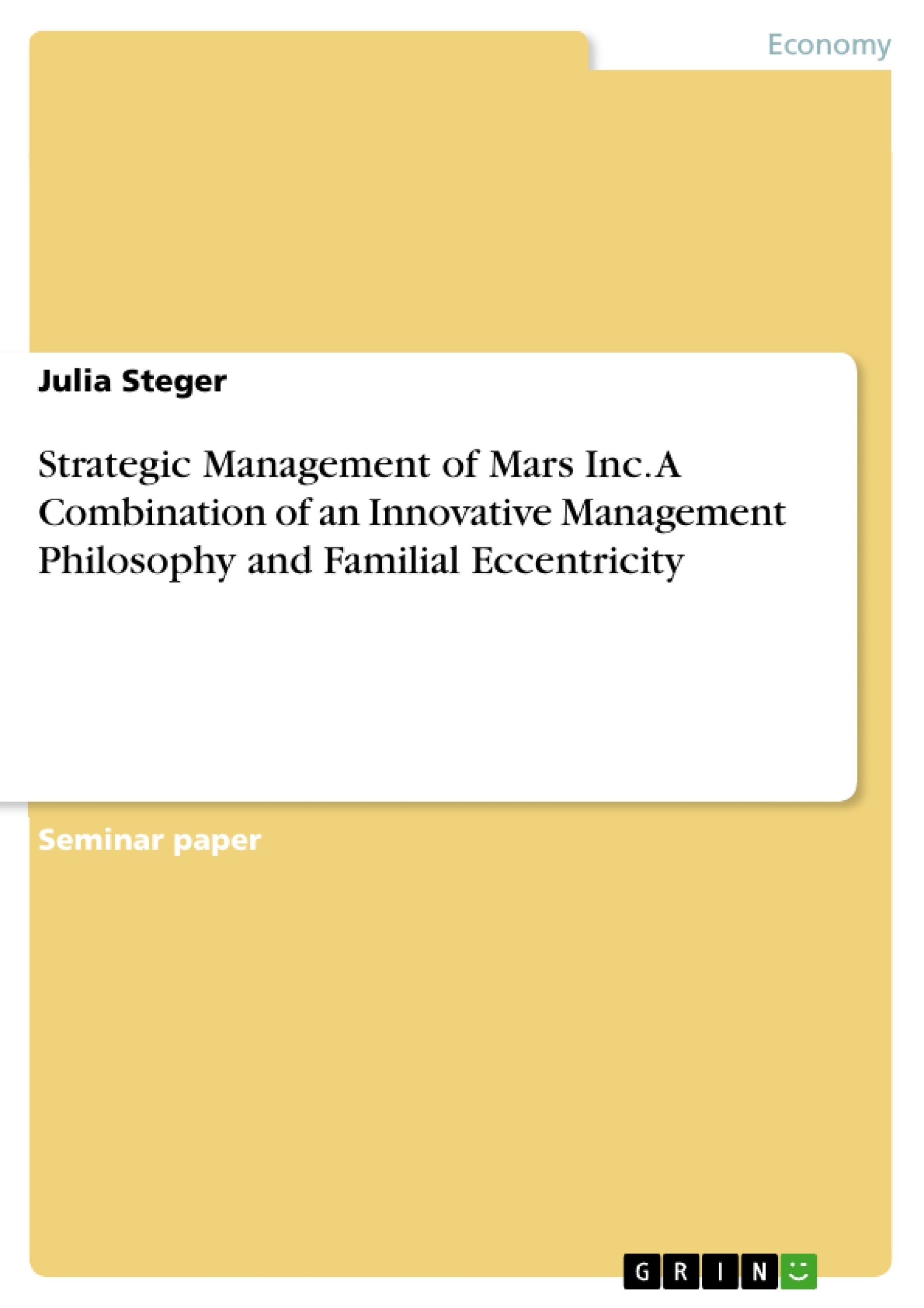Mars Inc. is a very unique company with a distinct strategy. As one of the biggest privately owned companies with a remarkable market share and revenue, Mars sets new dimensions to building, enabling and promoting a mission that involves mutual benefits for every stakeholder in a highly competitive and demanding environment.
Mars Inc. is one of the most productive and profitable privately owned companies operating in the food sector with an estimated revenue of US$33 billion in 2013 (“Mars Inc. Company Profile,” 2014). With a history of over a hundred years of being a highly successful business, Mars is a very special example for a sustainable but distinct company strategy.
Strategic management allows a business to conduct a environmental analysis that then enables the company to meet various business challenges in order to meet customer and stakeholder demands to gain a competitive advantage in its market (Dawson & Andriopoulos, 2014). Mars’ strategy, which is a combination of an innovative management philosophy and familial eccentricity, will be further described in this paper. Therefore external and internal influences on the company will be shown as comprehensive as possible, since a lot internal matters are kept a strict secret by Mars.
The paper will roughly outline the external influences by covering a PESTEL analysis and Porter’s Five Forces, show how Mars positions itself on the market, sketch the company’s internal HR practices, define its core competencies and conclude with Hambrick and Fredrickson’s Major Elements of Strategy. Some more detailed analysis (a longer version of the PESTEL evaluation) can be found in the appendix. As already mentioned Mars acts in a few different markets including chocolates and pet food, which all have their very own power balances and specialties. This paper, however, will give an overview of the company’s general market position in the food processing industry and will not specify on one business segment in particular.
Inhaltsverzeichnis (Table of Contents)
- Introduction
- External Analysis
- PESTEL Analysis
- Porter's Five Forces
- Positioning
- Internal Analysis
- Human Resources
- Core Competencies
- Hambrick and Frederickson's Major Elements of Strategy
- Conclusion
Zielsetzung und Themenschwerpunkte (Objectives and Key Themes)
This paper aims to analyze the strategic management of Mars Inc., a highly successful privately owned food company, focusing on its unique strategy and positioning within a competitive market. It explores the company's external and internal influences, including the PESTEL analysis, Porter's Five Forces, and internal HR practices, to understand how Mars achieves its objectives and sustains its competitive advantage.
- Strategic management of a privately owned company
- External and internal influences on business strategy
- Competitive advantage through differentiation and cost leadership
- The role of core competencies and human resources in achieving strategic goals
- The impact of Mars' Five Principles on its operations and culture
Zusammenfassung der Kapitel (Chapter Summaries)
The introduction provides background information on Mars Inc., its history, ownership structure, and key business segments. It also introduces the Five Principles that guide the company's operations and culture.
The "External Analysis" chapter examines the external environment in which Mars operates, using the PESTEL analysis and Porter's Five Forces model to identify key influencing factors. The PESTEL analysis discusses social trends, environmental threats, and legal regulations, while Porter's Five Forces examines the bargaining power of suppliers and customers, the threat of new entrants and substitutes, and the intensity of competitive rivalry.
The "Positioning" chapter explores how Mars positions itself in the market, using Porter's framework for competitive advantage. It discusses how Mars achieved cost leadership through efficient production and strategic pricing, and how it leveraged its brand recognition to gain a strong market position.
The "Internal Analysis" chapter delves into the internal workings of Mars, focusing on its human resources practices and core competencies. It explores how Mars attracts and retains talent, fosters a strong company culture, and leverages its unique capabilities to achieve its strategic goals.
The chapter on "Hambrick and Frederickson's Major Elements of Strategy" applies this framework to analyze Mars' strategic approach. It examines how Mars aligns its mission, objectives, and resources to achieve sustainable success in the long term.
Schlüsselwörter (Keywords)
The primary keywords and focus topics of this paper include strategic management, private ownership, Mars Inc., Five Principles, PESTEL analysis, Porter's Five Forces, cost leadership, differentiation, human resources, core competencies, and competitive advantage.
- Quote paper
- Julia Steger (Author), 2015, Strategic Management of Mars Inc. A Combination of an Innovative Management Philosophy and Familial Eccentricity, Munich, GRIN Verlag, https://www.grin.com/document/301541




